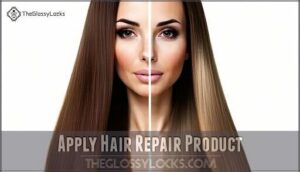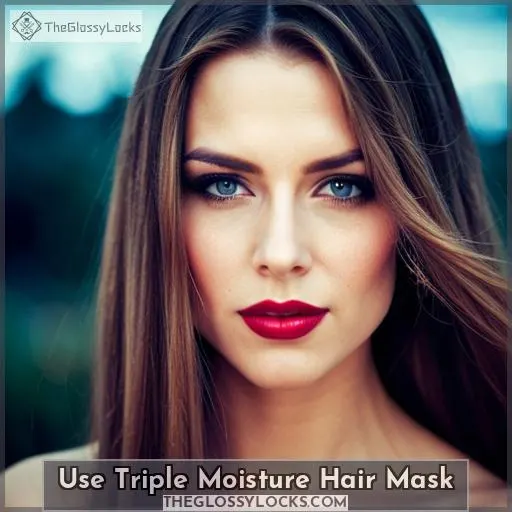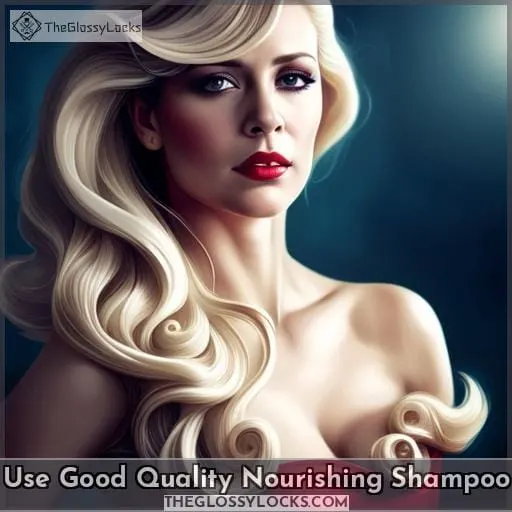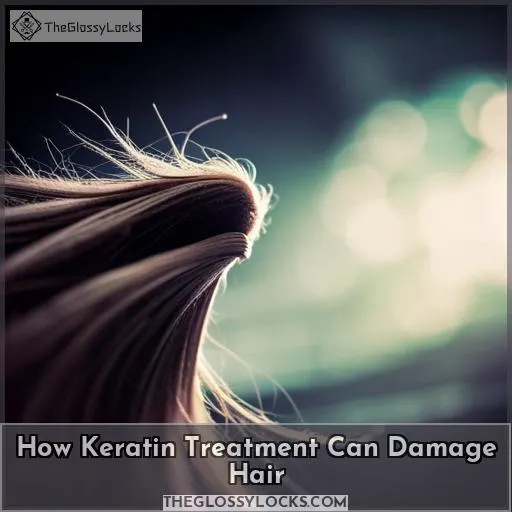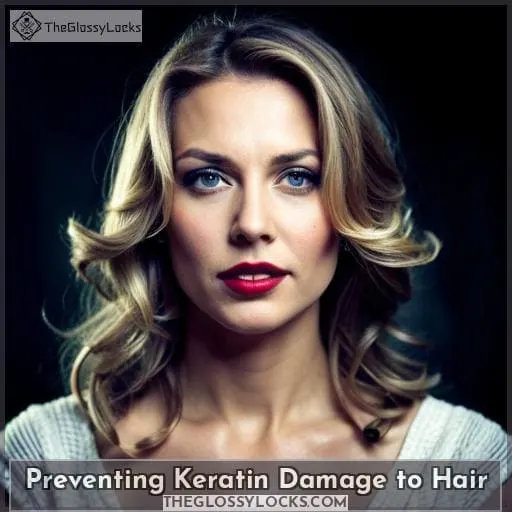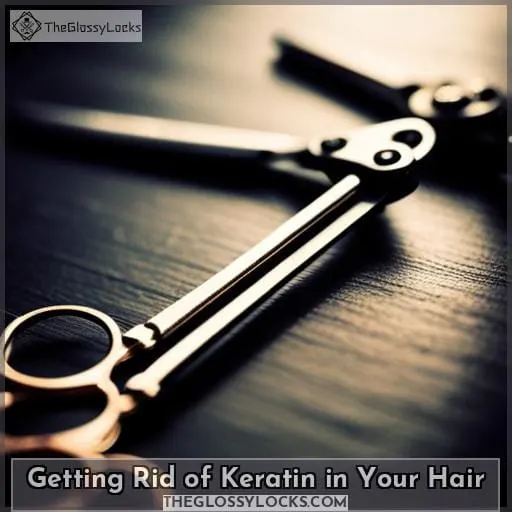This site is supported by our readers. We may earn a commission, at no cost to you, if you purchase through links.
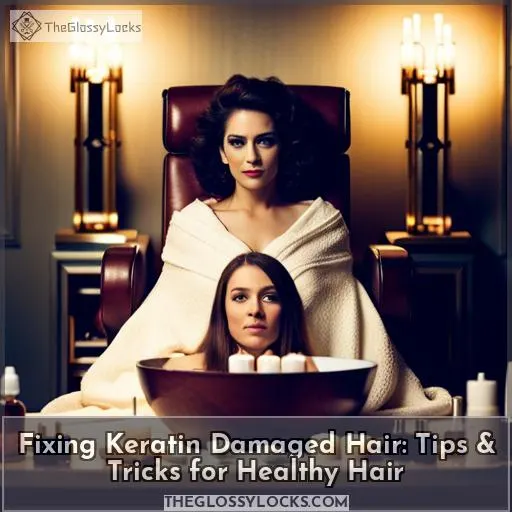 You ever have one of those days where everything seems to go wrong? You just got a keratin treatment, hoping it would make your hair look and feel better. Instead, you find yourself with damaged and dry hair – not exactly the results you were expecting.
You ever have one of those days where everything seems to go wrong? You just got a keratin treatment, hoping it would make your hair look and feel better. Instead, you find yourself with damaged and dry hair – not exactly the results you were expecting.
If this sounds familiar, then don’t worry! We’ve put together some tips on how to fix keratin damaged hair so that you can restore luster back into your locks.
With these simple tricks and techniques in hand, restoring healthy-looking tresses won’t be such a daunting task after all! So let’s get started by taking a closer look at what is Keratin Treatment as well as what causes it to damage our precious manes.
Table Of Contents
- Key Takeaways
- Apply Hair Repair Product
- Use Triple Moisture Hair Mask
- Use Good Quality Nourishing Shampoo
- What is Keratin Treatment?
- How Keratin Treatment Can Damage Hair
- Preventing Keratin Damage to Hair
- How Long Does a Keratin Treatment Last?
- Getting Rid of Keratin in Your Hair
- Frequently Asked Questions (FAQs)
- Conclusion
Key Takeaways
- Trim ends
- Use sulfate-free shampoo
- Use moisturizing masks/oils
- Avoid high heat styling
Apply Hair Repair Product
To repair your locks and restore their strength, try a hair repair product that replenishes what’s been lost. A good quality nourishing shampoo is an ideal way to start the process of restoring keratin-damaged hair.
Follow up with a triple moisture hair mask once or twice per week for 10 minutes or more to ensure maximum hydration and elasticity in your tresses.
Natural oils can also be used as protective products against further damage – use them sparingly but regularly for optimal results.
When using any high-heat styling tools such as blow dryers, curling irons, flat irons, etc., always make sure you’re protecting your strands with heat protectant before application. This will significantly reduce the risk of future breakage due to excess heat exposure! Additionally, it may be beneficial to trim off any split ends caused by overprocessing.
High-quality keratin treatment products should also be used when attempting repairs on keratin-treated locks. These specialized treatments offer advanced protection from environmental stressors while simultaneously helping rebuild broken bonds within the shafts themselves, which helps prevent future fractures and splits of weakened strands.
Women who have experienced severe damage due to excessive manipulation (brushing/pulling) should consider investing in a deep conditioning service at least once every few weeks too. This intensive treatment helps fortify damaged fibers so they become stronger than before! Lastly, don’t forget about finishing touches like silk pillowcases, which provide extra cushioning against friction during sleep time hours, thus reducing overall wear and tear on already fragile filaments each night.
The best way to maintain healthy-looking tresses after repairing them is through proper maintenance: wash no more than three times weekly, avoid harsh chemicals like sulfates whenever possible, retain moisture levels by applying natural oils between washes if needed, and always remember that prevention is better than cure when it comes to taking care of one’s mane! With careful attention given towards upkeep along with regular trims and employing appropriate protective measures when necessary, you’ll soon find yourself enjoying long-lasting luscious locks again sooner rather than later!
Use Triple Moisture Hair Mask
Try replenishing your hair with a triple moisture hair mask once or twice a week for 10 minutes or more to help rebuild broken bonds and keep damage at bay.
Not only does this intensive treatment provide the hydration benefits of natural oils, but it also offers thermal protection from heat styling tools like blow dryers and curling irons – protecting both color and texture.
Regular trims every few weeks are also essential in helping maintain healthy-looking keratin-treated locks since they remove split ends that can further weaken already fragile strands!
When shopping around for products to care for your tresses, be sure to look into those made specifically by manufacturers who specialize in treating keratin-damaged hair.
Their nourishing conditioners may even be able to help restore elasticity back into weakened fibers as well as lock down proteins within the shafts themselves, which increase strength against future breakage due to manipulation such as brushing or pulling too hard on wet strands.
With proper maintenance, including weekly deep conditioning treatments alongside regular trims & protective measures before applying hot tools, you’ll soon find yourself enjoying soft & silky smooth manes again sooner than later!
So don’t forget about finishing touches such as silk pillowcases; these will not only add extra cushioning against friction during sleep time hours but help retain moisture levels between washes too – all while restoring maximum healthiness back into each strand so you can feel confident about showing off luscious locks wherever life takes you!
Use Good Quality Nourishing Shampoo
Complement your weekly deep conditioning treatment with a good quality nourishing shampoo to replenish and strengthen weakened strands, creating smooth locks you can be proud of! The right product should help lock in moisture while providing heat protection from styling tools.
Paraben-free shampoos are ideal for maintaining the integrity of keratin-damaged hair since they don’t contain any harsh chemicals that could strip away valuable hydration or weaken follicles further.
For extra care, look into conditioners specifically designed for repairing broken bonds; these will offer superior protection against future damage caused by manipulation such as brushing or pulling too hard on wet strands.
Lastly, make sure to avoid excessive use of styling aids like hairspray; this will only encourage more breakage in time due to its strong hold ability plus lack of necessary nutrients needed during growth phases that keep hair healthy long term.
What is Keratin Treatment?
Keratin treatment is an amazing way to strengthen and protect your hair, giving you smooth, glossy locks that will last for months with proper care! This process involves introducing a chemical content onto the hair shafts, which fills in any cracks or fissures caused by environmental factors such as heat styling or poor selection of salon products.
The result? A sleek style that won’t suffer from breakage anytime soon.
When picking a stylist for this type of service, it’s critical to select someone who is experienced and certified – otherwise, you’ll risk doing more damage than good! It’s also important to use high-quality keratin products when washing your mane so as not to strip away its natural oils.
Look into conditioners specifically designed for repairing broken bonds if possible too. Heat protection should be applied before using hot tools on already fragile strands as well – opt for formulas with lower temperatures so they don’t dry out the fibers even further.
At-home treatments are essential after treatment has been completed too. Weekly deep conditioning masks help retain moisture, and adding nourishing shampoo regularly helps replenish weakened strands while providing extra hydration throughout each strand without overloading them with proteins either (which can cause further issues).
Finally, always remember to use a heat protectant spray before applying hot tools alongside silk pillowcases.
How Keratin Treatment Can Damage Hair
Keratin treatments may seem like a dream come true for those looking to revamp their locks; however, it is important to be aware of potential damage that can occur. The high heat used in the sealing process, protein overloads from products and formaldehyde, as well as excessive manipulation, are all factors that could lead to breakage and split ends, ruining your desired look – so don’t forget to trim the ends! With proper precautions and care, you can still enjoy beautiful hair without the risk of major damage.
High Heat Used to Seal Keratin Treatments
Be careful with the high heat used to seal keratin treatments, or you could end up with fried tresses! Too much of it can cause protein overload and formaldehyde buildup that breaks hair bonds. To avoid damage, seek out a certified salon for your treatment and use gentle handling during styling.
Weekly deep conditioning helps retain moisture while avoiding excess manipulation keeps breakage down – don’t forget to apply heat protectant before each use too! High-quality products are essential as well – choose those specifically designed for repairing broken strands in order to keep your mane healthy and strong.
Protein Overload
Too much protein can lead to an overload, causing your mane’s bonds to break – so watch out for those deep conditioning masks and oils! High-quality products are key; low-heat styling is recommended. Heat protectant helps keep damage at bay while gentle handling prevents frayed strands.
Formaldehyde
You should be extra cautious with keratin treatments, as the formaldehyde used in them can leave your locks looking limp and lifeless. Protect your hair by investing in chemical-free texture change products like Brazilian Keratin that offer heat protection without damaging effects.
Make sure to use high-quality nourishing shampoo and conditioner when washing out the treatment for best results, and opt for a sulfate-free option if possible!
If you notice damage reversal or significant texture changes after treatment time, it may be time to switch up your routine.
Excessive Manipulation
Avoiding excessive manipulation of your hair is key to maintaining the results of a keratin treatment. Over-brushing and pulling can weaken strands, undoing repairs. To keep locks looking luscious, lower heat styling temperatures; nourish with oils or masks; use a gentle handling approach; weekly deep conditioning and paraben-free heat protectant when using hot tools.
Trim the Ends
Regularly trimming the ends of your hair helps keep it looking healthy and strong. This is especially important for those who have had a keratin treatment, as inexperienced stylists or poor-quality products can cause damage to strands.
To repair tips, use a heat protectant with hot tools; weekly deep conditioning; gentle handling; moisture retention with moisturizing hair masks 1-2x/week, and read product labels carefully during the treatment process.
Preventing Keratin Damage to Hair
After a keratin treatment, it’s essential to care for your hair properly in order to avoid damage. For the first 24-48 hours after the procedure, try not to wash, brush, or tie up your mane. Ensure that you are gentle with it at all times. Sleeping on a silk pillowcase can help reduce friction and retain moisture.
Avoid frequent wetting of the locks to prevent protein overloads from product buildup. Use intensive moisturizing treatments such as oil masks 1-2 times per week for 10+ minutes each time. This will replenish lost nutrients and repair any existing cracks or fissures caused by styling tools or bad handling habits.
No Washing, Brushing, or Tying Up for First 24-48 Hours
After your keratin treatment, it’s important to forgo washing, brushing, and tying up your hair for 24-48 hours.
- Avoid heat styling or lower temperature.
- Reduce manipulation, don’t overbrush or pull.
- Use oils and masks weekly to retain moisture.
- Use sulfate-free shampoo and conditioner with panthenol for elasticity.
- Seek help from a certified hair professional if excess keratin has built up.
- Invest in a silk pillowcase too – this will reduce friction on strands! A few simple steps can prevent damage and keep you looking fabulous longer.
Be Gentle With Your Hair
Gently brush your hair, using a high-quality heat protectant when needed and avoiding excess manipulation, to keep it healthy and looking its best. Make sure you use a good quality shampoo and conditioner with panthenol for elasticity.
Incorporate weekly masks or moisturizing hair masks into your routine for deep conditioning. This will help manage the keratin in your locks while making them softer too! Invest in a deep-conditioning mask once every two weeks as well.
It’ll make sure that all the nutrients are locked in so you can enjoy soft, manageable hair for longer periods of time.
Sleep on a Silk Pillowcase
To keep your hair looking its best, sleep on a silk pillowcase to reduce friction and retain moisture. Silk fabric helps with heat retention while also protecting the hair from split ends. Choose this bedding choice for softer, smoother locks – apply oil or conditioner before sleeping too! Panthenol shampoo/conditioner adds elasticity, and saltwater can help protect against damage as well.
Avoid Frequent Hair Wetting
Avoid washing your hair excessively, as over-wetting can lead to damage and dryness. To keep hair healthy, maintain a moisture balance by using heat styling sparingly, deep conditioning regularly with conditioner or oil, and moisturizing masks.
Clarifying shampoo helps remove buildup, while keratin helps control frizz and lock in shine with proper care.
Use Intensive Moisturizing Treatments
Give your hair intensive moisture with weekly treatments like an oil- or panthenol-based conditioning mask.
- Deep condition regularly;
- Use a heat protectant before styling hot tools;
- Wash sulfate-free for maximum benefit;
- Treat strands to oils and masks for extra softness;
- Handle gently – no excess brushing/pulling. Home keratin treatment is possible too! Weekly intensive moisturizing will give you the best results without damaging your tresses.
How Long Does a Keratin Treatment Last?
With proper care, a keratin treatment can last up to six months, while poor upkeep can reverse the effects in as little as four weeks.
- Reduce heat styling; use only low-temperature tools when necessary.
- Deep condition weekly with quality products like shea butter oil and panthenol-based conditioners for extra elasticity and moisture retention.
- Prevent damage by using high-quality products specifically designed for keratin treatments, avoiding excess manipulation of the mane such as brushing too hard or pulling it back tight into styles that may cause breakage over time, and using protective agents like heat protectants before hot tooling each time you style your locks!
These simple steps will help ensure that your hair remains healthy long after any type of chemical process has been done on it – from salon color treatments to relaxing services all the way down to basic trims at home! By taking special precautions against excessive exposure to damaging elements post-treatment, you’ll be able to enjoy soft, silky tresses far longer than if left untreated.
Getting Rid of Keratin in Your Hair
To reverse the effects of keratin treatments, try trimming ends and regularly using products that replenish moisture while avoiding excessive heat styling.
Start by cleansing your hair with a sulfate-free shampoo to remove any product buildup from previous treatments.
Next, apply a moisturizing hair mask or oil for at least 10 minutes to help restore hydration levels in the strands.
Then use conditioning treatments such as panthenol-based conditioners, which will add elasticity back into your mane before applying protective products prior to any heat setting process you may do on it.
Additionally, consider getting regular trims if you notice split ends beginning to form and deep conditioning weekly so that each strand receives an extra dose of nourishment!
Lastly, lower temperatures when hot tooling is necessary – this can be done by investing in quality tools with adjustable settings or even switching up hairstyles altogether!
With all these steps combined, it should help rid of keratin buildups over time while preserving its healthy state for longer periods without sacrificing beautiful results!
Frequently Asked Questions (FAQs)
How often should I use a triple moisture hair mask?
Experience the transformative power of a triple moisture hair mask! Use it 1-2 times per week for 10+ minutes to repair, hydrate, and restore damaged locks.
What are the benefits of using a good quality nourishing shampoo?
Using a good quality nourishing shampoo can help add moisture, strength, and elasticity back to your hair.
What alternatives are there to keratin treatments?
Try alternatives to keratin treatments, such as protein-based hair masks, moisturizing shampoos and conditioners, deep conditioning masks, oil therapy, or even avoiding heat styling.
What are the effects of using too much heat when styling my hair?
Using too much heat when styling your hair can cause it to become dry, brittle, and prone to breakage. It may also damage the protective cuticle layer, resulting in split ends and frizziness.
What other ways can I protect my hair from damage?
To protect your hair from damage, think of it like a delicate flower – treat it with gentleness. Use gentle handling and low-heat styling, wash 1-3 times per week to retain moisture, and use masks for additional nourishment.
Conclusion
Have you ever wondered how to fix keratin-damaged hair? Keratin treatments are a great way to repair broken hair, but if not done properly, they can lead to further damage. It’s important to be aware of the causes of damage, how to prevent it, and how to fix it.
Applying a hair repair product, using a triple moisture mask, and using a good quality nourishing shampoo are just a few ways to repair keratin-damaged hair. Knowing how to prevent keratin damage and how long a keratin treatment will last can also help you keep your hair healthy.
When it comes to getting rid of keratin in your hair, trimming the ends and using intensive moisturizing treatments can help reverse the damage. With the right knowledge and proper care, keratin-damaged hair can be restored to its original glory.

